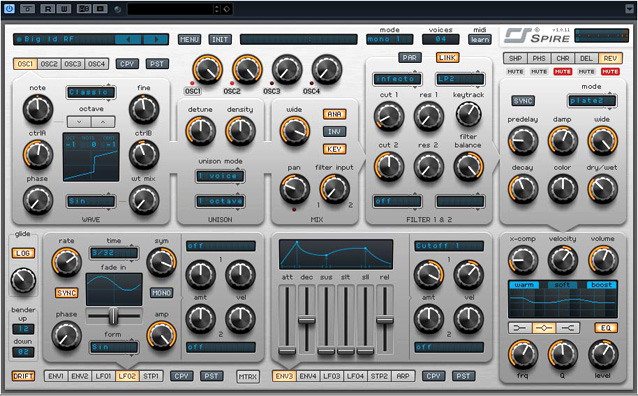Reveal Sound is a relatively new company and their first product is a synth called SPIRE. It’s a 4 oscillator synth with the options: classic, noise, fm and amsync. According to the developers it is a polyphonic synthesizer that combines powerful sound engine modulation and flexible architecture, a graphical interface provides unparalleled usability. Spire is the embodiment of the best opportunities, both software and hardware synthesizers. Let’s dive in and see what this synth is all about.
Options
Classic Mode: In this mode, you can crossfade between a saw and a square waveform (the square can have its pulse width adjusted) and you can mix this with the wavetable waveforms.
So pulsewidemodulation(PWM) mixed up with wavetable synthsesis, which gives you a wide variety of options.
Noise Mode: Noise generation that can be shaped by filters.
FM Mode: Frequency modulation mode. You can modulate any waveform from the Wave list. The modulator signal is a Sine wave.
AMSync Mode: This combines oscillator sync with amplitude modulation.
Unison
A wide range of options are available and each oscillator can have its own unison. Choose the number of voices (up to 9), its spread and one of the following modes:
● 1 Octave all voices are distributed in the current octave (regular unison);
● 2 Octave part of the voices are distributed in the current octave while the rest of the voices are distributed one octave up;
● 3 Octave voices are distributed evenly between three octaves;
● Cmaj chrd unison voices form a major chord;
● Cm chrd unison voices form a minor chord;
● Cmaj7 unison voices form a major seventh chord ;
● С7 unison voices form a major chord with a minor seventh;
● Cmmaj7 unison voices form a minor chord with a minor seventh;
● Cm7 unison voices form a minor chord with a major seventh.
Then there’s the density knob that can give a different flavour to the unison, supersaws and hypersaws are easy as pie but they can give a different spin on them when you expirement with the density and detune knobs.
Filters
There are two filters; both can be set to different modes independently. Each mode has different filter types. The filters can be routed in parallel or serial.
These are the filter modes and their respective types:
● Perfecto with the characteristics of analog and digital filter types. Modes: LP4, BP4, HP4, Peak.
● Acido a 303 like filter. Modes: LP1, LP2, LP3, LP4.
● Infecto a virus like filter. Modes: LP2, BP2, HP2, Notch.
● Scorpio a filter mix up between analog and digital. Modes: RedLP2, RedLP4, BlackLP2, BlackLP4, BlackHP, BlackBP.

Modulation section
4 envelopes, 4 lfo’s, 2 stepsequencers called stepper and a matrix field for the routings. Envelopes are adsr (attack,decay,sustain,release) shapes but each stage can be shaped by clicking on the graphic display. So its very easy to make convex shapes etc, great for recreating old juno like attacks.
Lfo’s
Lfo rate is capable of high speed great for edm growls, it can be host tempo controlled or freerunning. Phase, Form and sym can be adjusted for different shapes. Plenty of options to shape the lfo to your liking.
Stepper
Stepper is an advanced step sequencer with a flexible waveform editor. For each step, you can assign a unique waveform. Very complex sequences can be made because you can draw weird shapes and connect the stepper to any parameter you like.
Matrix
The matrix has 15 slots, each of which have 2 sources and 4 targets. Potential sources Include: oscillators, LFO, envelopes, MIDI signals and MIDI controllers. So bucketloads of signal routing possibilities!
Effects section
With a shaper, phaser/vowel, chorus/flanger, delay, reverb (plate 1&2), compression and eq on board you can tailor the sound in many ways. Shaper’s available modes are: Soft, Warm, Hard, Clip, Tube1, Tube2, Tube3, FBsin, FBtri, Flt+dcm (filter+decimator), dcm (only decimator). The ability to low and high cut the signal and distort only the band part is very cool.
Phaser and Vowel: Stages – mode selection: 6 Stages, Vowel Low, Vowel Mid, Vowel Hi; Pre – if it is enabled, the effect will be before the shaper in the signal chain.
Chorus and Flanger: Mode – the first mode is Flanger. Other modes (2 6) activate different Chorus algorithms.
Delay: Ping Pong and regular stereo delay of a good quality and easy to dial in.
Reverb: Solid sounding reverb with predelay,sync, dampening, widening and coloring options and ofcourse dry wet output stage.
Three band Eq and last but not least the xcomp multiband compressor, to keep your sounds in check and easy to mix.
There’s also a fullblown arpeggiator on board that has next to the standard stuff like up /down,random, also the option to trigger steps from the step seq, and chord to trigger held notes using the step seq. Also a swing knob that makes it a breeze to make your seq shuffle.
Verdict
The sound of this synth is very good and tight, good for modern patches, cpu consumption is pretty acceptable and the gui is not that hard to learn. I also really like the copy and paste functions all over the gui, definately a timesaver. Small nitpicking I found during testing is that the rate of some knobs like pan are going up from left to right, so if you want to set exact panning per osc say 200 (which is left) and 700 (which is right) you have to figure out the numbers. A far better way is to divide them into half so you can say 200 left/200 right. quicker and far easier way to do this imho.
All in all this is a great synth that’s definately worth checking out. For more info visit: www.reveal-sound.com.


